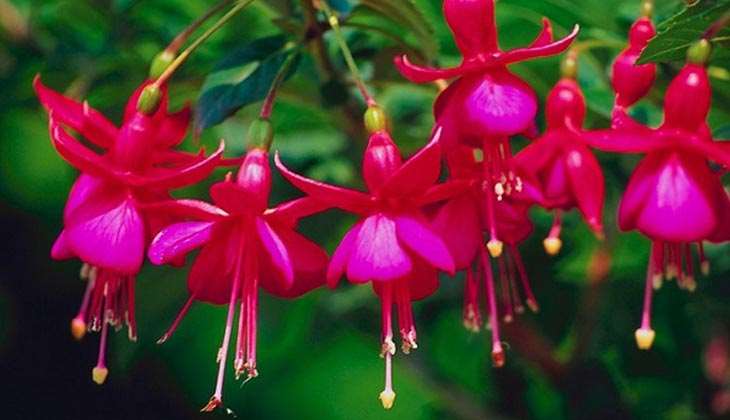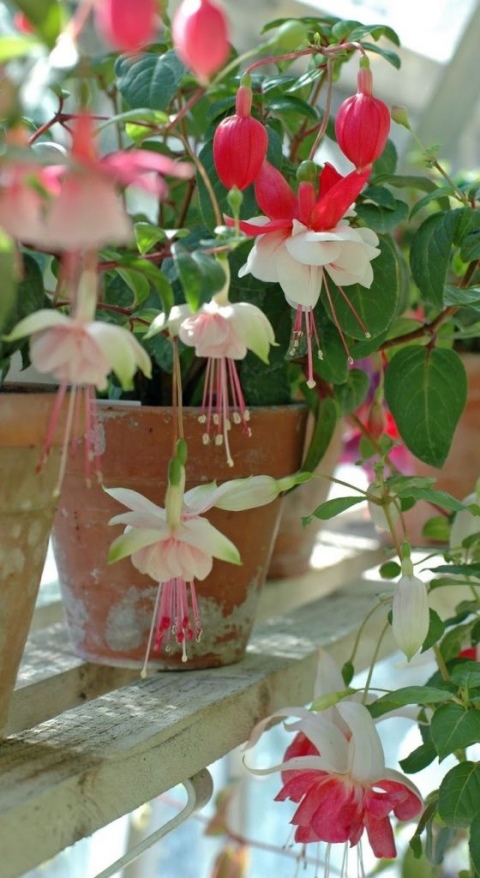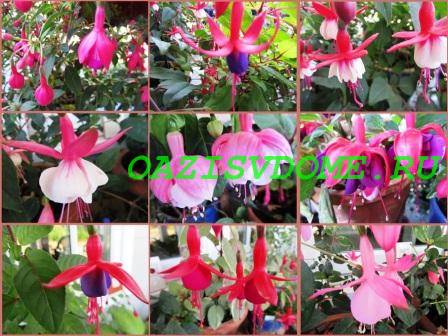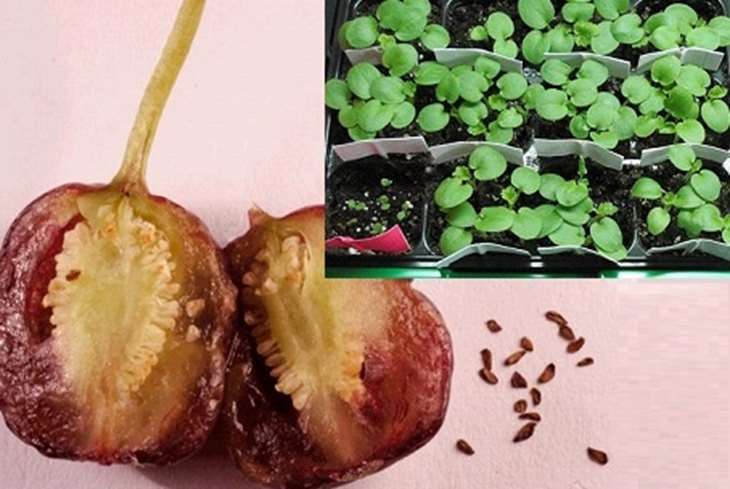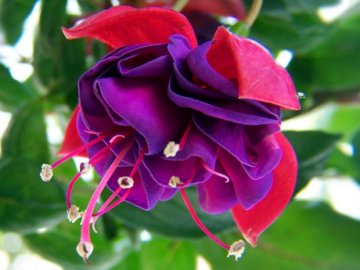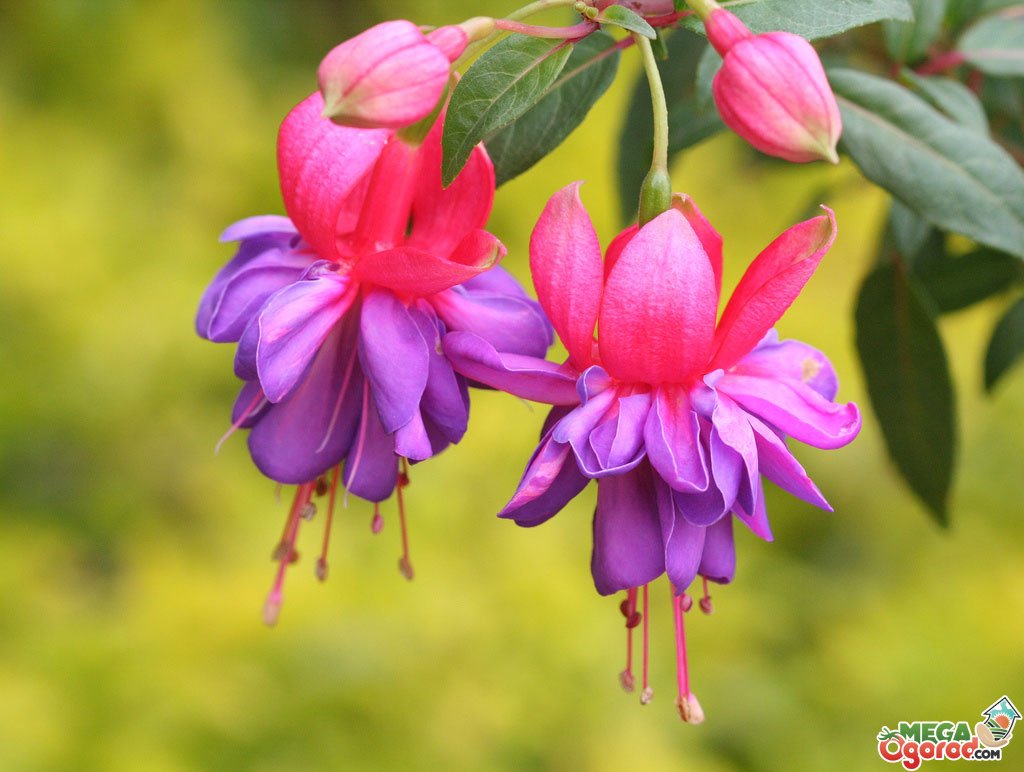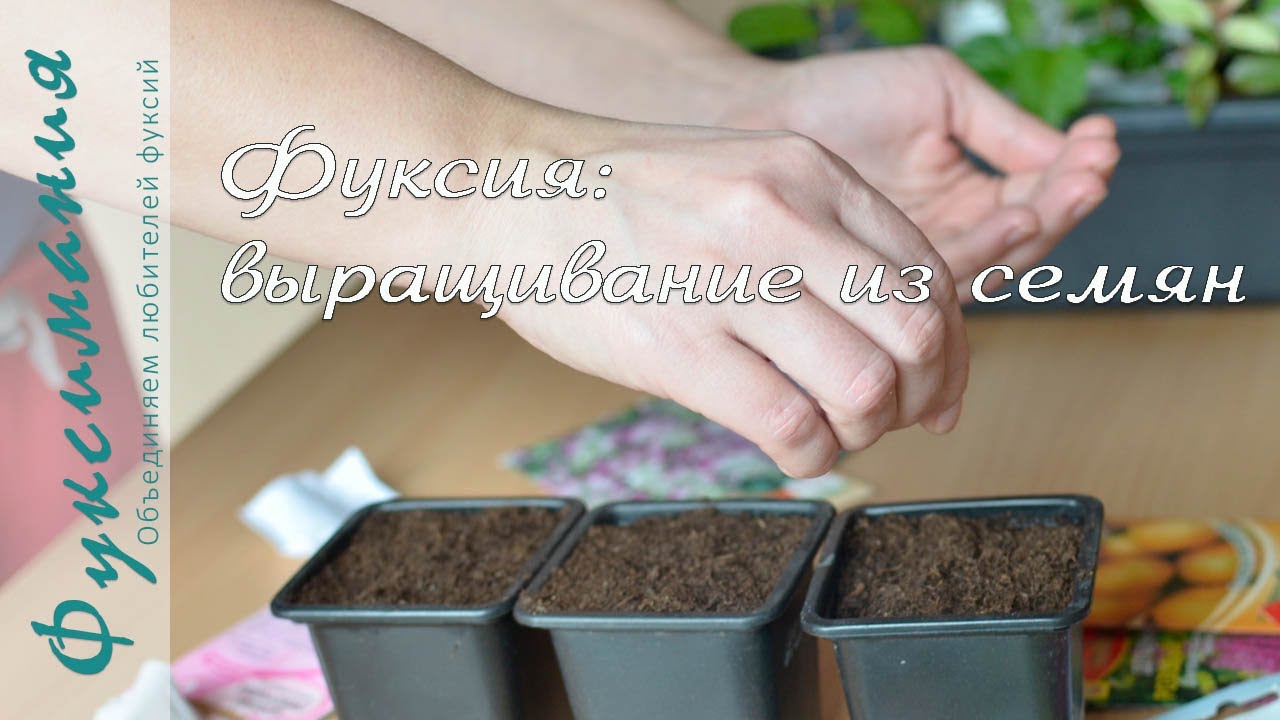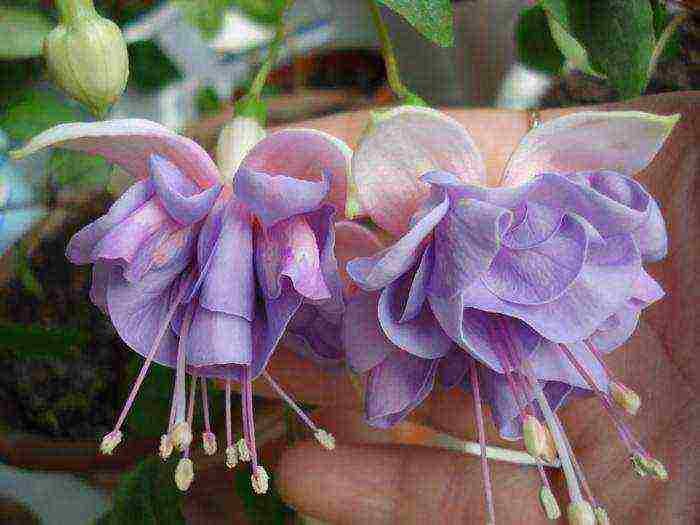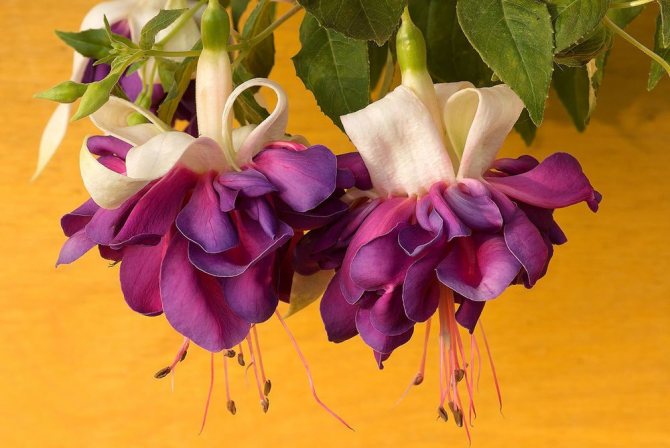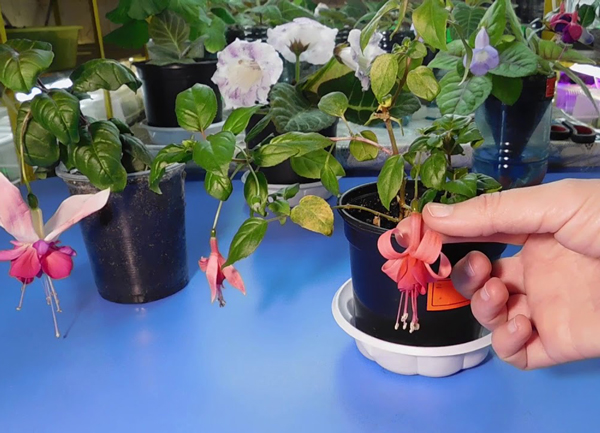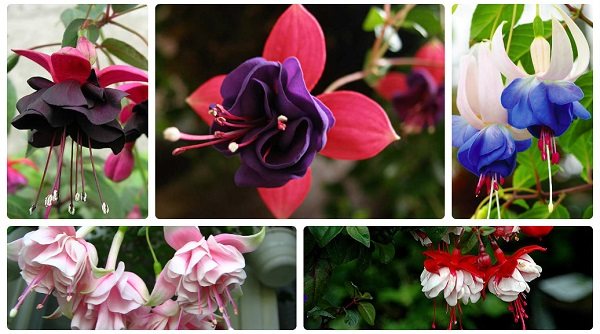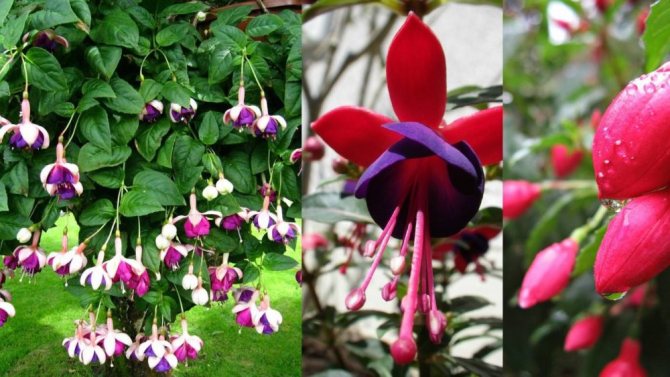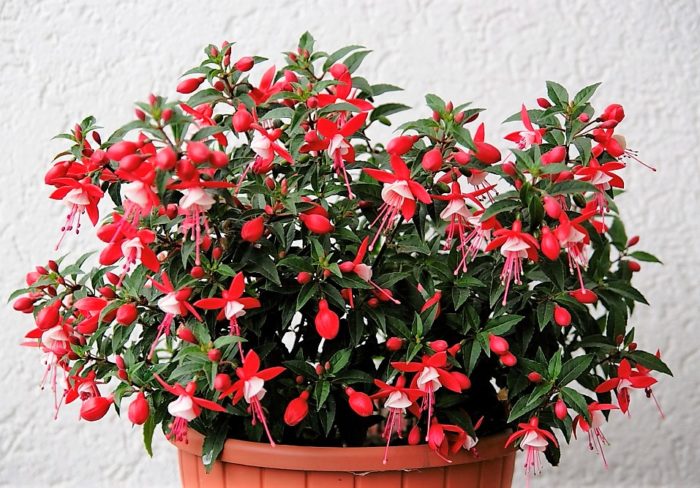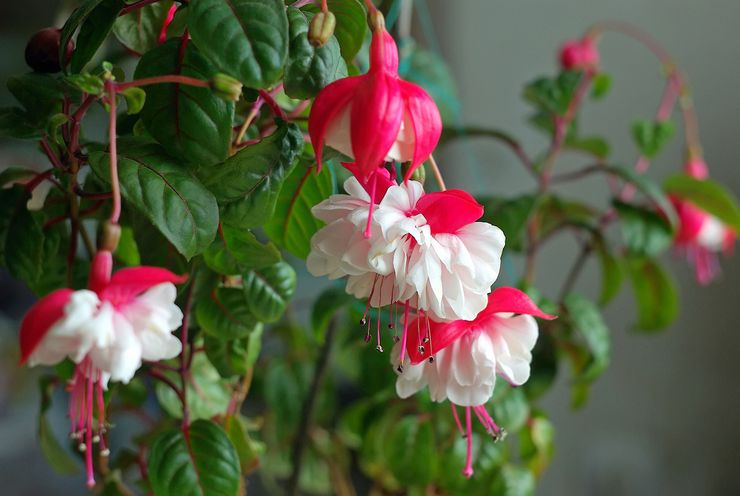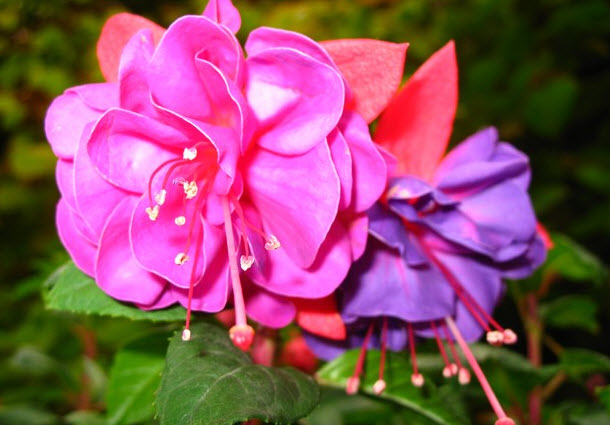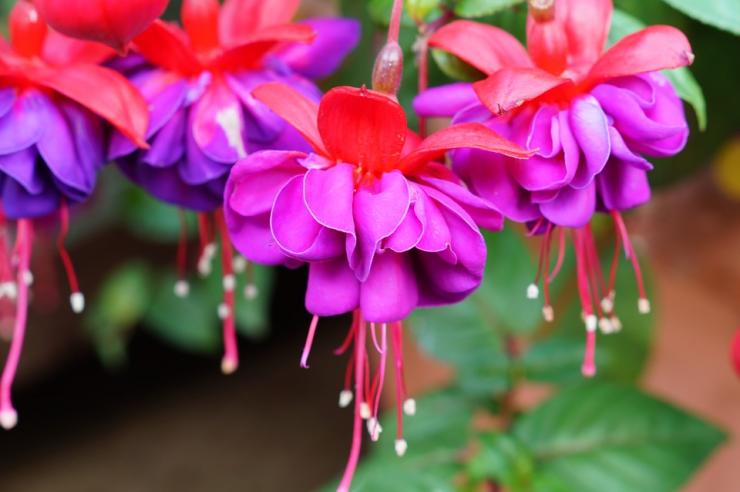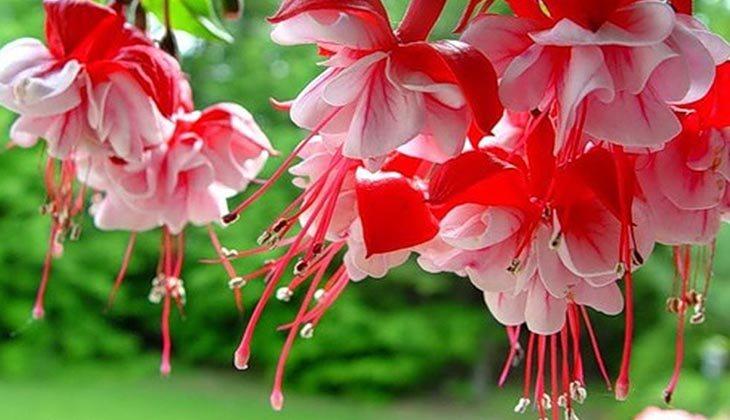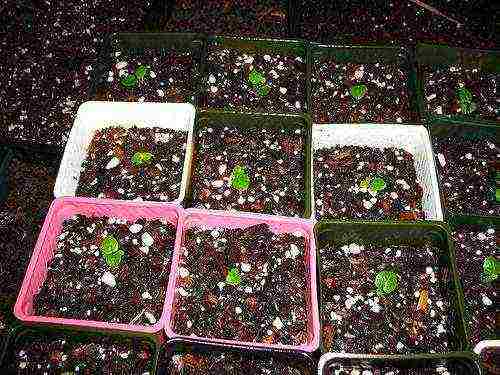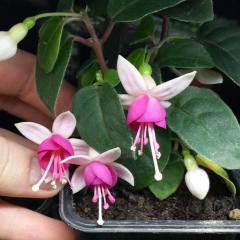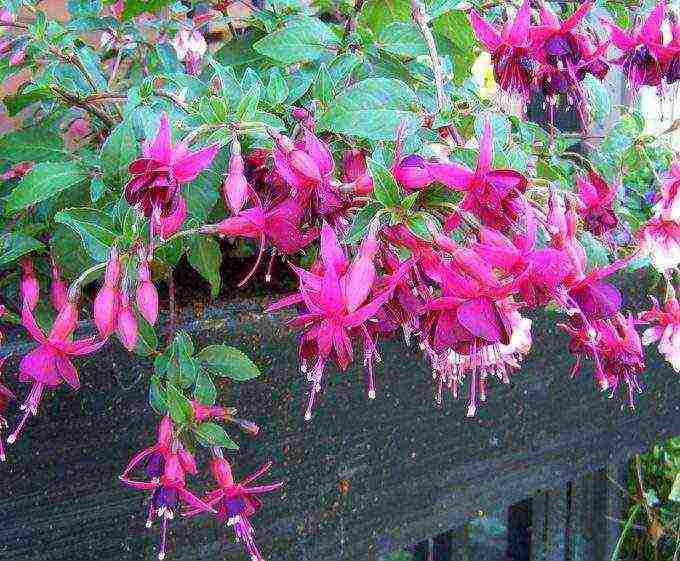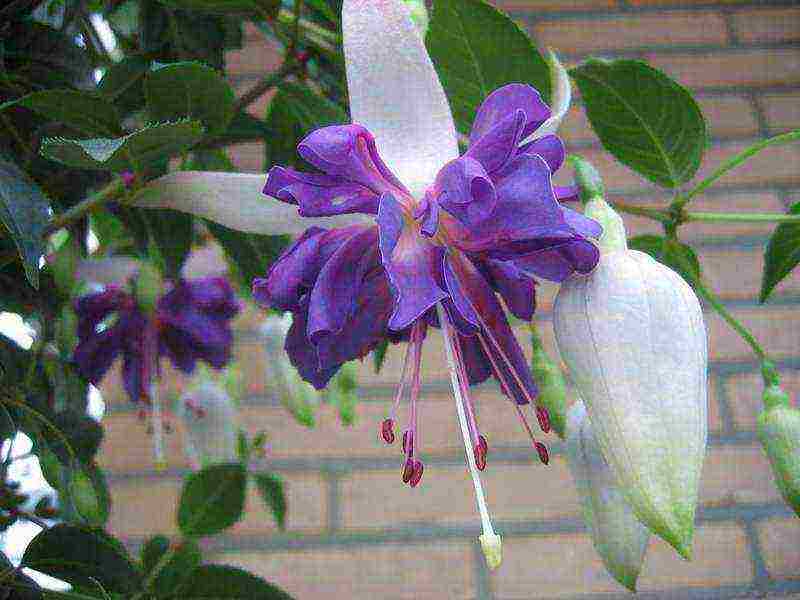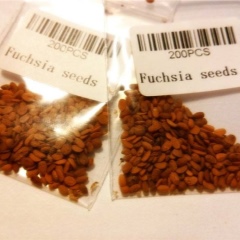2.Fuchsia home care
2.1. Reproduction, growing from seeds
Fuchsia propagates vegetatively - stem cuttings 8 - 10 cm long or sowing seeds in spring.
The lower leaves are removed from the cuttings and the bases are immersed in powder for rooting.
For planting, small plastic cups or pots with drainage holes are prepared.
The bottom of the containers is lined with a layer of small pebbles, expanded clay or foam balls - such a layer will facilitate the early removal of moisture from the roots.
The cups are filled with nutritious and loose soil, the surface of which is thoroughly moistened with a spray bottle with water at room temperature.
The bases of the cuttings are immersed 1 - 2 cm into the surface of the soil.
Cover young plants with clear plastic or glass to maintain even moisture.
New growth usually appears within a month. Cuttings can even be rooted in water.

2.2 Housekeeping, pruning
If it is possible to keep the plants cool during the dormant period, caring for fuchsia will not take you much time and effort. Some varieties need regular pinching of the apical buds to form a dense crown - others can be formed as a standard tree. It will also be very interesting to grow fuchsia as a flowering tree - bonsai. Tall plants may need a support to grow. Remove withering flowers promptly to extend flowering time. Tall fuchsias will need formative pruning in early spring.
Bring the fuchsias out into the garden during the warm season, taking care of the gradual acclimatization of the plants to the new conditions. In the fall, plants may lose their leaves - this is normal in some species. The faded shoots of the plant are cut off, and after a month they begin to grow again and often repeat flowering. Weak diseased plant shoots should be removed using a sharp, sterile pruning tool.
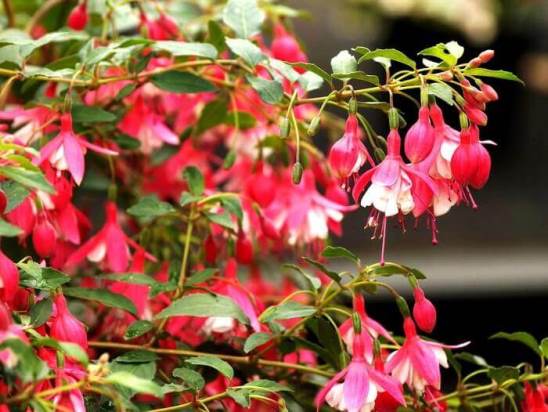
2.3 Transplanting fuchsia
Fuchsia at home prefers cramped conditions - so its flowering will be more abundant. Repot the plants in early spring, before new growth begins. The planting pot should have large drainage holes.

From spring to autumn, fuchsias are able to bloom very abundantly and continuously.

2.5 Diseases and pests
Leaves shriveled with insufficient watering. Direct rays of the sun on hot days can cause burns on the leaves. Overdrying the soil during the flowering period causes the plants to shed their buds. Leaf tips turn brown and dry when kept in an atmosphere that is too dry. Of the most common problems, fuchsias can shed their leaves, sometimes this happens in the fall before the plants go into dormancy, and then this is normal. When grown in high humidity conditions, fuchsia can also turn yellow and fall off the leaves - such symptoms can be caused by magnesium deficiency.
Of the harmful insects on plants, whiteflies, aphids, and spider mites sometimes appear.
Pot transfer
Some time after the sowing was performed, after the second pairs of real leaves appear in the plants, they should be dived - planted in individual containers:
- Transplant containers should be light and small. Ideal - plastic cups of 100 or 200 ml with holes in the bottom of each of them.
- Planting plants should be carried out in the same way as planting seedlings - in a layer of soil and drainage.
- Seedlings must be very carefully transplanted into cups, leaving the earthy clods intact and sprinkling them with earth.
- After the soil dries out, regular, but moderate watering of the plants will be required in pallets or along the edges of the containers.
- It is also periodically necessary to spray the seedlings with water using a spray bottle, as well as top dressing with complex fertilizers, which should be carried out twice a month.
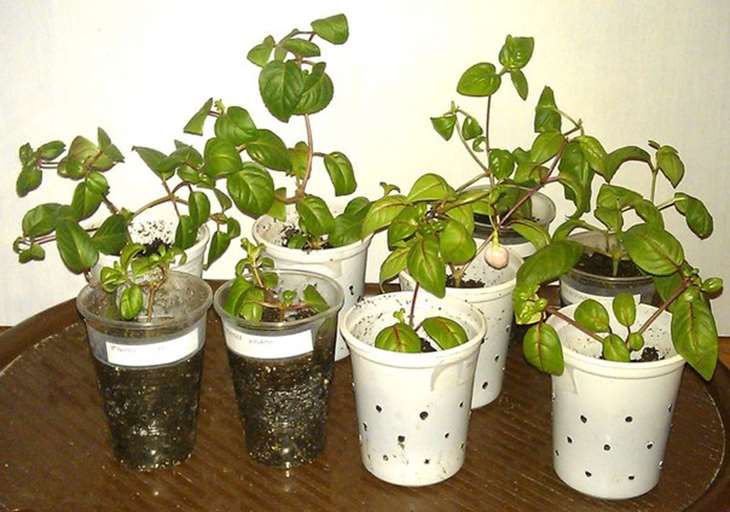
When pulling out, the fuchsia must be pinched. Otherwise, the bush will not be compact. Cutting off the top is carried out with the active growth of the plant. This way it will form well and be plump, healthy and very strong.
When it becomes noticeable that the seedling cup has become very small, the plant should be transplanted into a pot, the diameter of which is 2-4 cm larger. When sowing seeds, you can count on the appearance of flowers in a year.

Agrotechnics
Fuchsia is a universal culture. In the process of growing, it can be given any shape:
- bush;
- standard;
- pyramidal;
- ampelous;
- spreading;
- climbing;
- can be grown as bonsai.
Different varieties of fuchsia can bloom at different times and have a variety of flower colors. Thus, you can collect a whole series of varieties of culture. This will make it possible to ensure the flowering of fuchsia from early spring to late autumn. And it blooms profusely and for a long time.
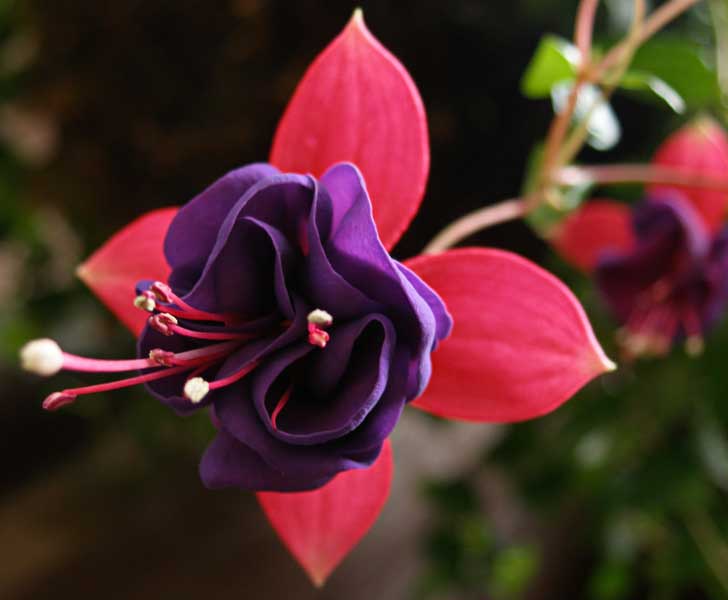
Fuchsia
The most popular varieties:
Terry:
- Fashion;
- Swingtimes;
- Midge.
Semi-double:
- Walts;
- Tennessee;
- Satellite;
- Snowkup.
Simple (non-double):
- Winston Churchill;
- Bon Accord.
- Brutus.
- Cystic flower:
- Svoili Yellow;
- Leverkusen.
The plant prefers bright diffused lighting (in the morning), partial shade (at noon, in the afternoon until the evening). It is best to settle fuchsia on the windowsills of the east or north windows. In summer, you can take it out onto the balcony, into the courtyard. Place it in a place where the sun's rays are only in the morning. In winter, you need to provide the flower with additional illumination - up to 11 - 12 hours / day. Phyto lamps or fluorescent lights are used.
Attention! To prevent fuchsia from getting burned, it is necessary to cover it with a light cloth or paper. Fuchsia loves coolness
Comfortable temperature in summer - no more than + 20 degrees, in winter +15 degrees
Fuchsia loves coolness. Comfortable temperature in summer - no more than + 20 degrees, in winter +15 degrees.
The flower grows well on light, breathable soils (peat can be added). There should be no stagnant water.
The plant does not tolerate excessively dry air. From this, leaves and buds may turn yellow, fall off. The preferred humidity is 50-60%. Therefore, you should regularly spray the plant with a spray bottle in the summer, especially in the heat, in the morning or in the evening. The water should be separated, at room temperature. You can place a wide container filled with water next to the flower, or put a pot of fuchsia on wet pebbles or expanded clay, poured into a pallet.
Important! Experienced growers do not recommend rearranging fuchsia from one place to another, as well as periodically turning it to the rays of the sun in different directions. The culture does not like it, it can drop all the buds
Water the plant regularly, in moderation, after the top layer of the earth dries out (every 3-4 days). This is especially required for fuchsia during the flowering period in summer. When late autumn comes, watering is reduced. In winter, irrigate no more than 1-2 times a month.
In March, they begin to feed the flower (every 10 days). Use means for flowering indoor plants. In winter, no top dressing is applied.
Pruning is carried out 2 times a year (early October, early January). The dormant period for the plant begins in late autumn (October), lasts all winter.
Fuchsia is transplanted in the spring. The culture is propagated by seeds, cuttings.
The plant can be affected by powdery mildew, rust, root rot, spider mites, whitefly, and aphids.

How to propagate fuchsia at home with seeds
Possible difficulties in breeding fuchsias
It should be borne in mind that cuttings should be guided by the following rules.
Optimal conditions
The optimal temperature regime should not be violated. The temperature should not fall below 14 ° C or rise above 24 ° C.
Although watering is required so that the root system does not dry out, it is also necessary to spray the bushes 1-2 times a day. When the cold season comes, the life of the plant stops. Therefore, in winter, watering must be minimized.
Provide proper lighting. Fuchsia loves bright light, but it shouldn't be scorching. The best choice is abundant diffused lighting. When grown at home for fuchsia, the best place will be window sills near the most lighted windows.
Important! If there is a lack of natural light, artificial light can be used. As soon as flowers appear, it is not recommended to transfer the flower to a new place.
This may cause flowering to stop.
As soon as flowers appear, it is not recommended to transfer the flower to a new location. Because of this, flowering may stop.
On the street, fuchsia can be grown if it is located in the shade.
Watering is necessary every time the topsoil begins to dry out
During hot weather, it is important to carry out the procedure daily.
For your information! Ampel fuchsias are grown by placing several cuttings in one pot.

Planting cuttings of fuchsia
Top dressing
The flower needs to be fed regularly. For this, it is necessary to use complex fertilizers. This must be done during the period when the fuchsia is blooming. At this time, you need to choose fertilizers with a high content of phosphorus and potassium. Top dressing should be done on a weekly basis throughout the year with the exception of the winter period. Fuchsias growing outdoors need to be fed with organic fertilizers.
Note! Each spring, these flowers must be transplanted into a new soil.
Care features
Removing dried flowers and leaves is important. It is necessary to regularly loosen the soil. To combat pests, you need to inspect the plant.
If there is not enough light, then the plant is able to shed flowers. The stems will stretch strongly under such conditions.
It is important to consider that the roots do not react well to overheating. It is necessary to keep fuchsia in such conditions that the temperature for the flower is comfortable
Although these flowers are undemanding to care, one must nevertheless take into account that they do not tolerate excess moisture well. If this problem is not solved in time, then root rot will occur, which will spread to the leaves. As a result, the flower may die.
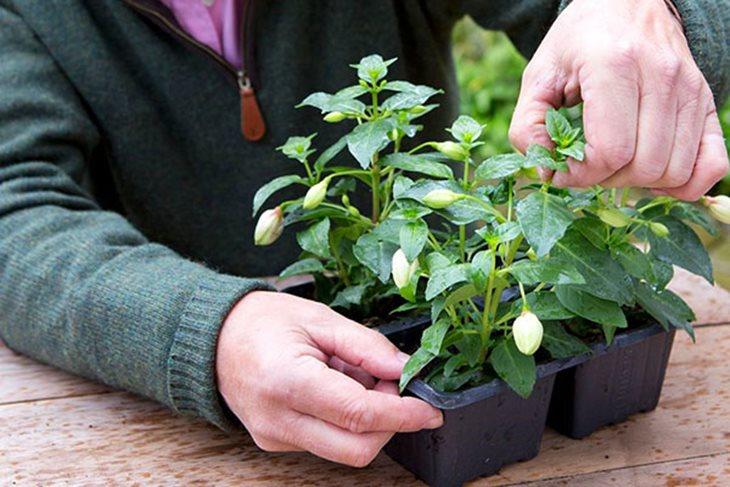
Growing in plastic containers
Pest and disease control
The presence of excess moisture creates favorable conditions for the plant to become infected with a fungal disease with gray rot. To cure fuchsia from it, it is necessary to use special fungicidal preparations. Products with a high copper content can also help.
Note! For the treatment of fungal diseases, the use of Bordeaux liquid at a concentration of 1% is effective. Rust is also dangerous for the plant.
This is when yellow-orange spots form on the leaves. At the first stage of infection, the lower leaves begin to fall off intensively. In the future, all the rest fall off. If a sick flower is treated with the help of the drug virtan, then this will help cure the flower.
Rust is also a danger to the plant. This is when yellow-orange spots form on the leaves. At the first stage of infection, the lower leaves begin to fall off intensively. In the future, all the rest fall off. If a sick flower is treated with the help of the drug virtan, then this will help cure the flower.
For a plant, not only diseases can be dangerous, but also insect pests.Aphids, spider mites and whiteflies can attack the flower. These insects, hitting fuchsia, are located on the lower part of the leaves and feed on the sap of the plant. At the same time, the leaves dry out, turn yellow and fall off, due to the fact that they do not receive nutrition.
Suitable insecticides must be used to control insect pests.
Fuchsia growing from seeds at home, is it possible?
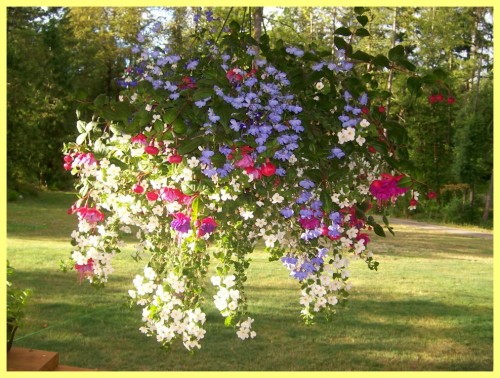
Fuchsia usually propagates by cuttings. They take root well. They do not create any special problems for flower growers. When Fuchsia is needed, growing from seed at home is rarely used. It is carried out for breeding purposes only. Sometimes for the sake of experiment.
It is possible to grow fuchsia from seeds. But where to get the seeds? They are bought at a flower shop. Seeds can also be harvested from the flowers of a house plant. The procedure for obtaining seeds is quite interesting.
To begin with, exclude the possibility of self-pollination. To do this, the anthers are torn off on the selected flower. Then the pollen of the variety you want to grow is applied to the stamens. The bud is wrapped in gauze and fixed with a thread. In this form, the flower should stand for several weeks until the fruit is formed. During this period, the flower cannot be moved so as not to damage the structure.
Once the fruit is ready, it is removed from the stem. You should carefully cut it and get the seeds. They are dried for several days before being planted in the ground. Sowing fuchsia is desirable in the spring, around March or April.
For sowing, wooden boxes are prepared with a special mixture (peat, coarse sand). Seeds are not sown very deeply. Otherwise, they may not germinate at all. The seeds are carefully placed on the surface of the soil and lightly pressed with your fingers.
The box is covered with polyethylene or glass to create greenhouse conditions. The optimum temperature for growing seeds is 15 or 20 degrees Celsius. Lighting for a small greenhouse should be of good quality. But, try to keep the box out of direct sunlight.
Each day, the greenhouse needs to be aired for 15 minutes. You also loosen the soil in the box and remove condensation from the film, which has formed from the temperature drop. Watering of future plants is carried out with a flower sprayer. The water should be separated and at room temperature.
If all conditions are met, the first shoots will appear in a maximum of 15 days. The drawer can now be left open for longer. This is done until the young plants adapt to room temperature and normal air humidity.
An unpretentious Fuchsia plant, growing from seeds at home involves maintaining moisture in the soil. Young growth is sprayed every day, the plant loves moisture. Keep the sprout box in a well-lit place. Plants need diffused light.
After the young growth has grown, it's time to start planting it in separate pots. Before this, the plant dives, throwing out weak and unusable shoots. Fertile land is used for planting young plants. It is best to take garden soil, flavored with humus and crushed leaves, sand. Wood ash can be added to the pot as fertilizer.
Before replanting the plants, the soil is well watered. Youngsters are removed one by one from the box along with the soil at the root system. Seated 1 piece in a pot, watered abundantly. Young pots should be removed to a dark place to get used to the new environment.
Young plants are replanted every year. This is necessary for abundant flowering. If the fuchsia doesn't get enough nutrients from the ground, it won't bloom.
Further care for the young is simple: put in a well-lit place, water regularly, feed 14 days after transplanting. Fuchsias can be fertilized with nutrients to feed flowering plants every two weeks. Fertilizers are applied to the soil from early spring to late October.
When fuchsia begins its active flowering period, the plants are fertilized every week. This helps to prolong the flowering period and to ensure active formation of inflorescences. Fuchsia grows upward and over time resembles a tree. Do you want to grow a bush? As the plant grows, its top is cut off. This stimulates the growth of lateral shoots, the plant resembles a bush.
Pruning is important during the period of active growth of young stock. Plants will be lush and strong. Fuchsia grows quickly, growing from seeds at home does not require special skills. Having grown 50 plants, you will not only decorate your apartment, but you will also have something to put up for sale.
Transplant rules
The transplant is carried out in the spring, and the composition of the land for transplant is as follows:
- Sod layer - 2 parts.
- Peat - 1 part.
- Pine bark and sand - ½ part each.
A universal soil is also used, which is sold in stores. The transplant container is used with an average depth, so that the flower develops normally. Drainage is laid at the bottom, in the form of expanded clay, its layer is about 5 cm. Soil is poured over the drainage. Before transplanting, the flower must be cut, removing the shoots by 1/3.
After transplanting a flower, it is thoroughly watered and constantly sprayed with water. In a short time, fresh shoots appear and the plant blooms. When a white, yellow plaque appears, it is removed and the soil is added.
Main types
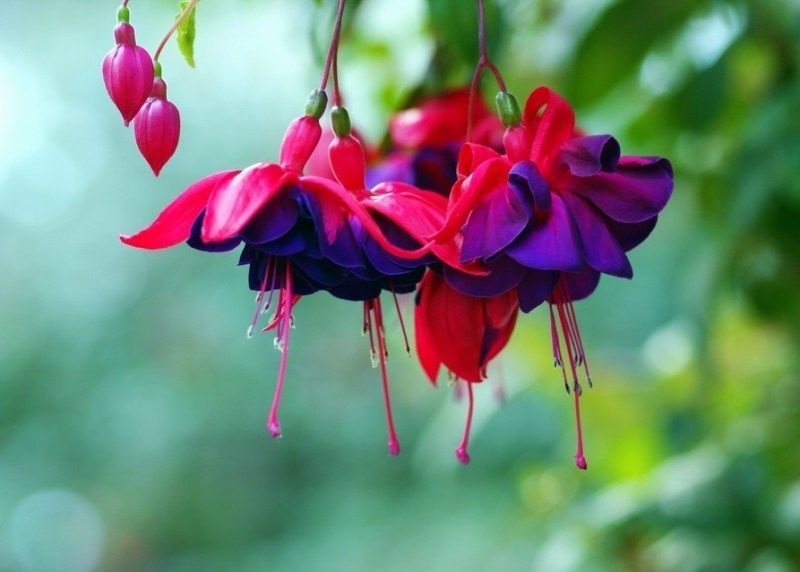
Fuchsias in the garden are grown from hybrid varieties, having previously grown seeds in a pot
For growing fuchsia at home, hybrid varieties of this plant are most suitable. As a rule, these are small trees or bushes. But it is possible to keep it in hanging pots of ampelous species.
-
Three-leafed. A bush with sizes up to 60 centimeters, which tends to grow in breadth, therefore it can be used to decorate walls in hanging baskets.
Reddish green above and brownish red below, the leaves are 8 centimeters in size and resemble an egg in their shape. The veins on the leaves are slightly pubescent. Flowers with a bell shape and orange-red color, collected in inflorescences of five to seven pieces. The flowering period is from May to October, but with careful and proper care of the plant, it can be significantly increased.
-
Magellan. A shrub that can reach a height of 3 meters when fully developed. The leaves are purple in color, with a traditional fluff along the veins, measuring 4 centimeters. When flowering, single flowers are formed, but there may be inflorescences of 4 flowers each.
Flowering occurs from early spring to early autumn. It tolerates cold well.
- Lying. A creeping plant that is mainly used as an ampelous plant. When blooming, it gives a variety of shades of pink and orange. The flowers themselves are always directed upward and grow singly. Blooms from spring to autumn.
- Sparkling. A plant that grows up to 2 meters and has large, 12 cm wide and 20 centimeters long, serrated leaves. After flowering, the berries are collected in brushes and are edible. Blooms from June to late August.
-
Graceful. A relative of the Magellanic, it reaches a height of one meter with room maintenance, and in nature it can grow up to three meters.
The flowers are pink-reddish in color and are very beautiful. From spring to late autumn, you can enjoy the sight of these flowering plants.
- Bolivian. It blooms in early March and blooms until the end of April. A one meter high bush is decorated with long (up to 30 cm) peduncles, which gracefully hang from branches, with flowers gathered in bunches. It is necessary to keep it in a warm room, since this species does not tolerate cold.
-
Thin. Indoors it can grow up to 3 meters, so it needs pruning to stimulate growth in breadth. Leaves with a reddish tint, and flowers collected in brushes and hanging on long peduncles have purple and purple hues.
Flowering begins in July and lasts until the end of September.
- Thyroid.It can grow up to three meters, but with timely and correct pruning, usually more than one will not grow. Flowers of pink, purple, purple hue, collected in a brush and have a long and slender shape. From July to the end of September, flowering occurs.
- Bright red. From April to the end of September, the bush of the plant is strewn with red (scarlet) flowers with purple additives. Thin shoots hang down beautifully and are covered with oval green leaves in the shape of a heart. One of the most popular types for breeding fuchsia at home and at work (office).
- Hybrid. There are a great many such types of fuchsia. Some exist in only a few copies, since they were bred by amateur flower growers exclusively for themselves, having independently grown from sown seeds with hybrid pollination. Especially popular types are widely available - Ballerina, Alisson Bell, Henriett Ernst, Anabel, Thalia and Ampelnaya (Imperial Crown, Hollies Beauty, Blue Angel, Prince of Peace).
Common problems
The plant is susceptible to pests such as ticks or whiteflies. Find their waste products on the back of the leaves. They fight by spraying with special solutions that are sold in flower shops.

The leaves begin to wither and grow poorly in stagnant air, the flower needs freshness, but drafts should not be allowed.

The reason for the too short flowering period is the high temperature and abundant watering in the winter, or the lack of moisture and light in the spring.

Falling buds in summer means a lack of moisture or too high a temperature.

The spotted color of the leaves indicates too much watering.


